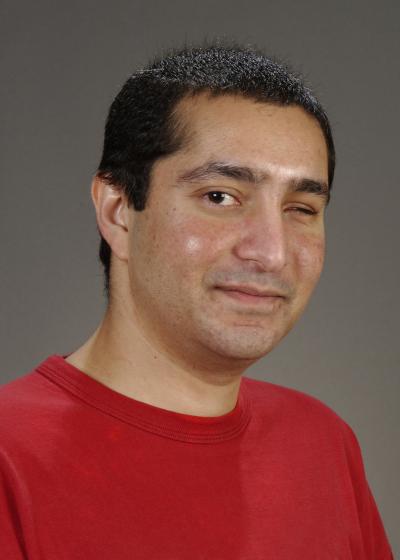February 10, 2005
How genomes make proteomes
“What we’re really doing,” says Dr. Ram Samudrala, who leads a Computational Biology Group and is an assistant professor in the Department of Microbiology, “is trying to understand how the genome of an organism specifies its behavior and characteristics.”
Samudrala works with proteomes, which are the sets of proteins encoded by genomes. In the same way that there is a human genome, there is a human proteome. And a rice proteome, a mouse proteome and a proteome for each organism. Genetic differences between one individual and another are reflected in each individual proteome.
Samudrala’s group, which is in the Rosen Building at South Lake Union, has analyzed the proteomes for more than 50 different organisms, using a variety of computational methods developed by his group.
He and his colleagues are using more than 320 computer processors at one time to make some of their calculations, and then pooling their data with others around the world. One of their grants funds work on the rice proteome, with the understanding that knowing how the rice genome creates the interrelated protein structures that make up the plant will enable researchers to help produce new forms of rice that are richer in nutrients.
Other work in the lab is looking at proteome interactions in host-pathogen infections, including the innate immune response of the host organism. The HIV proteome is another focus of study. It has what Samudrala describes as a “very small” proteome, with only 12 proteins. With advanced algorithms, he is trying to predict how a given HIV proteome might mutate, to predict HIV drug resistance and susceptibility.
“We want to have all the parts [of a proteome], and then we want to understand their structure and how they work together,” he says. “For a human mind, it’s just too much information to work with, but our computers can do this.”
Much of the creativity in his work involves developing the algorithms, or mathematical formulas, to have the computers pick out useful data. Samudrala’s group has developed several algorithms and software programs that are used for proteomic computations and works with other computational and experimental labs to develop more.
Samudrala will give the next Science in Medicine Lecture, sponsored by the School of Medicine’s Office of Research and Graduate Education, at noon on Thursday, Feb. 17, in room T-625 of the Health Sciences Center. His topic is “Modelling Proteomes.” The lecture is one of the “new investigator” presentations in the Science in Medicine series. It will also be simulcast to Harborview’s Research and Training Building Auditorium and the VA Seattle medical center, room 142 of Building 24.
Since he was a teenager, Samudrala has been interested in computers and genetics, and in the capacity of computers to help human brains understand how living organisms work. He earned a bachelor’s degree in computing science and genetics from Ohio Wesleyan University in 1993 and his Ph.D. from the Center for Advanced Research in Biotechnology in Rockville, Md., where he was a life technologies fellow working on protein structure prediction. He was a postdoctoral fellow at Stanford University, supported by the Burroughs Wellcome Fund, before he joined the UW faculty in microbiology in 2001.
He is a Searle scholar and his research is also funded by the National Science Foundation, the National Institutes of Health, Puget Sound Partners in Global Health and the UW Advanced Technology Initiative in Infectious Diseases.
Samudrala has strong feelings about the importance of making the work of his group widely available and working with others who share their results publicly. All the algorithms and data produced are publicly available on Webserver frameworks (Bioverse and Protinfo) that can be accessed through the Computational Biology Research Group site at http://compbio.washington.edu.



